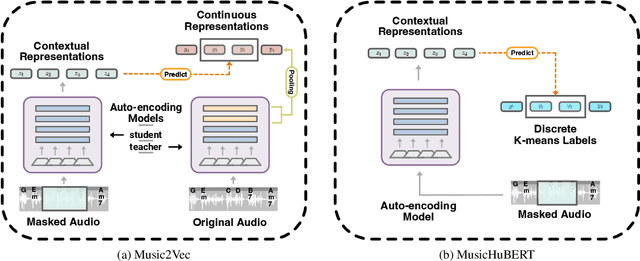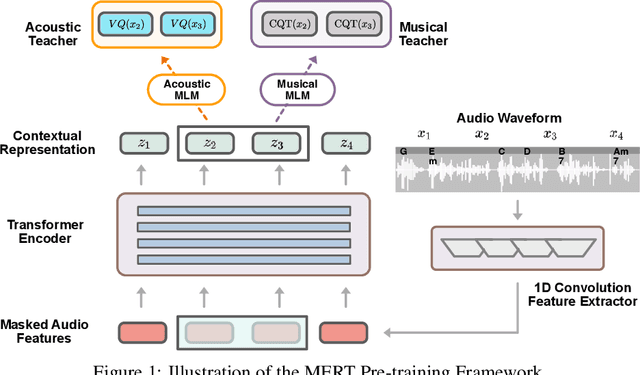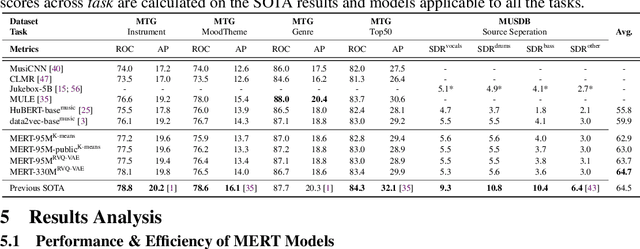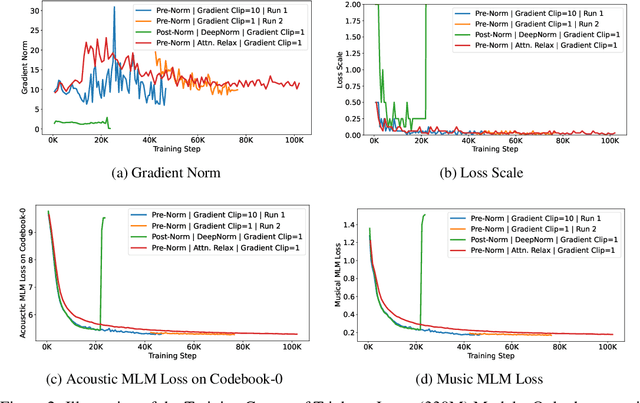Norbert Gyenge
MARBLE: Music Audio Representation Benchmark for Universal Evaluation
Jul 12, 2023Abstract:In the era of extensive intersection between art and Artificial Intelligence (AI), such as image generation and fiction co-creation, AI for music remains relatively nascent, particularly in music understanding. This is evident in the limited work on deep music representations, the scarcity of large-scale datasets, and the absence of a universal and community-driven benchmark. To address this issue, we introduce the Music Audio Representation Benchmark for universaL Evaluation, termed MARBLE. It aims to provide a benchmark for various Music Information Retrieval (MIR) tasks by defining a comprehensive taxonomy with four hierarchy levels, including acoustic, performance, score, and high-level description. We then establish a unified protocol based on 14 tasks on 8 public-available datasets, providing a fair and standard assessment of representations of all open-sourced pre-trained models developed on music recordings as baselines. Besides, MARBLE offers an easy-to-use, extendable, and reproducible suite for the community, with a clear statement on copyright issues on datasets. Results suggest recently proposed large-scale pre-trained musical language models perform the best in most tasks, with room for further improvement. The leaderboard and toolkit repository are published at https://marble-bm.shef.ac.uk to promote future music AI research.
On the Effectiveness of Speech Self-supervised Learning for Music
Jul 11, 2023



Abstract:Self-supervised learning (SSL) has shown promising results in various speech and natural language processing applications. However, its efficacy in music information retrieval (MIR) still remains largely unexplored. While previous SSL models pre-trained on music recordings may have been mostly closed-sourced, recent speech models such as wav2vec2.0 have shown promise in music modelling. Nevertheless, research exploring the effectiveness of applying speech SSL models to music recordings has been limited. We explore the music adaption of SSL with two distinctive speech-related models, data2vec1.0 and Hubert, and refer to them as music2vec and musicHuBERT, respectively. We train $12$ SSL models with 95M parameters under various pre-training configurations and systematically evaluate the MIR task performances with 13 different MIR tasks. Our findings suggest that training with music data can generally improve performance on MIR tasks, even when models are trained using paradigms designed for speech. However, we identify the limitations of such existing speech-oriented designs, especially in modelling polyphonic information. Based on the experimental results, empirical suggestions are also given for designing future musical SSL strategies and paradigms.
MERT: Acoustic Music Understanding Model with Large-Scale Self-supervised Training
Jun 06, 2023



Abstract:Self-supervised learning (SSL) has recently emerged as a promising paradigm for training generalisable models on large-scale data in the fields of vision, text, and speech. Although SSL has been proven effective in speech and audio, its application to music audio has yet to be thoroughly explored. This is primarily due to the distinctive challenges associated with modelling musical knowledge, particularly its tonal and pitched characteristics of music. To address this research gap, we propose an acoustic Music undERstanding model with large-scale self-supervised Training (MERT), which incorporates teacher models to provide pseudo labels in the masked language modelling (MLM) style acoustic pre-training. In our exploration, we identified a superior combination of teacher models, which outperforms conventional speech and audio approaches in terms of performance. This combination includes an acoustic teacher based on Residual Vector Quantization - Variational AutoEncoder (RVQ-VAE) and a musical teacher based on the Constant-Q Transform (CQT). These teachers effectively guide our student model, a BERT-style transformer encoder, to better model music audio. In addition, we introduce an in-batch noise mixture augmentation to enhance the representation robustness. Furthermore, we explore a wide range of settings to overcome the instability in acoustic language model pre-training, which allows our designed paradigm to scale from 95M to 330M parameters. Experimental results indicate that our model can generalise and perform well on 14 music understanding tasks and attains state-of-the-art (SOTA) overall scores. The code and models are online: https://github.com/yizhilll/MERT.
MAP-Music2Vec: A Simple and Effective Baseline for Self-Supervised Music Audio Representation Learning
Dec 05, 2022Abstract:The deep learning community has witnessed an exponentially growing interest in self-supervised learning (SSL). However, it still remains unexplored how to build a framework for learning useful representations of raw music waveforms in a self-supervised manner. In this work, we design Music2Vec, a framework exploring different SSL algorithmic components and tricks for music audio recordings. Our model achieves comparable results to the state-of-the-art (SOTA) music SSL model Jukebox, despite being significantly smaller with less than 2% of parameters of the latter. The model will be released on Huggingface(Please refer to: https://huggingface.co/m-a-p/music2vec-v1)
 Add to Chrome
Add to Chrome Add to Firefox
Add to Firefox Add to Edge
Add to Edge